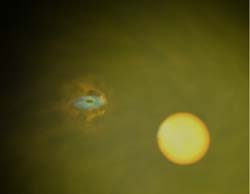This area deals with the fundamental laws and building blocks of nature and how they interact, the properties and the behavior of matter, and research into space and time and their structures.
innovations-report provides in-depth reports and articles on subjects such as astrophysics, laser technologies, nuclear, quantum, particle and solid-state physics, nanotechnologies, planetary research and findings (Mars, Venus) and developments related to the Hubble Telescope.

45th Annual Meeting of the Division of Plasma Physics
In work that makes practical, large-scale fusion energy production increasingly feasible, plasma physicists working at DOE’s DIII-D National Fusion Facility in San Diego are using a little chaos to prevent precious energy from escaping fusion energy devices.
In a magnetic fusion device, or tokamak, one of the most crucial regions for reducing the loss of heat and particles is at the plasma region’s edge. Partic

An asteroid that has eluded astronomers for decades turns out to be an unusual pair of objects traveling together in space, a UCLA planetary scientist and colleagues report.
The asteroid Hermes was rediscovered last week after being lost for 66 years. Now Jean-Luc Margot, a researcher in UCLA’s department of Earth and space sciences, has determined that the asteroid is, in fact, two objects orbiting each other. The two objects together would cover an area approximately the size

’Fly-bys’, or ’gravity assist’ manoeuvres, are now a standard part of spaceflight and are used by almost all ESA interplanetary missions.
Imagine if every time you drove by a city, your car mysteriously picked up speed or slowed down. Substitute a spacecraft and a planet for the car and the city, and this is called a ’gravity assist’. These manoeuvres take advantage of the fact that the gravitational attraction of the planets can be used to change the tra

Pierre Auger Observatory seeks source of highest-energy extra-terrestrial particles
With the completion of its hundredth surface detector, the Pierre Auger Observatory, under construction in Argentina, this week became the largest cosmic-ray air shower array in the world. Managed by scientists at the Department of Energy’s Fermi National Accelerator Laboratory, the Pierre Auger project so far encompasses a 70-square-mile array of detectors that are tracking the most violent-and perha

Integral, ESA’s powerful gamma-ray space telescope, has discovered what seems to be a new class of astronomical objects.
These are binary systems, probably including a black hole or a neutron star, embedded in a thick cocoon of cold gas. They have remained invisible so far to all other telescopes. Integral was launched one year ago to study the most energetic phenomena in the universe.
Integral detected the first of these objects, called IGRJ16318-4848, on 29 January 2003. Al

Rice physicists show that quantum methods can predict nanophotonic behavior
According to new research from Rice University, scientists studying the way light interacts with metallic nanostructures should throw out their old optics textbooks and bone up on their quantum mechanics instead.
The new findings, which are described in the Oct. 17 issue of the journal Science, offer a new understanding of plasmonics, an emerging field of optics aimed at the study of light at the nan